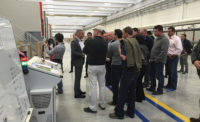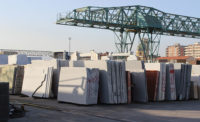On the technology side, SFA members saw the latest developments in large-scale machinery, table saws, CNC routers, CNC bridge saws, portable routers, grinders, tooling, adhesives, sealers and more. In the stone-production sector, the delegation saw all levels of stoneworking, including quarrying, block-cutting, slab processing, architectural stoneworking and hand craftsmanship. The tour also visited some localized fabrication plants that used machinery common to North American stone fabricators, such as bridge saws, CNC stoneworking centers and waterjets. Throughout the tour, the SFA members offered input on the various types of technology and how they could utilize it in their operations. At all of the technology supplier visits, the fabricators offered candid insight on how these products could be even more effective for the North American fabrication market. Stone World was fortunate enough to join the SFA delegation, and the pages that follow offer a look at what the fabricators saw during their journey through Italy.
Achilli srl — Cutting and Polishing Technology
Founded in 1950 as a general engineering and metal-working company, Achilli S.r.l. is well known in North America and across the world for its user-friendly stone working equipment.
In terms of sawing technology, the latest version of the MBS bridge saw (the MBS-TS) is specifically geared for stone fabricators who need to automate their cutting process but do not wish to introduce sophisticated equipment. It has a motorized hydraulic roller table to facilitate slab positioning. The MBS-TS contrasts heavy cast iron with lighter manufacturing techniques providing greater resistance to machining stress and thus guaranteeing the necessary cutting accuracy. It is not in competition with CNC bridge saws, but geared for small- and medium-sized shops. The unit features touch-screen controls, a visual and intuitive control system that works without traditional buttons. The touch-screen system is fitted with numeric control, which also allows surface profiling of the slabs. Achilli explained that the system is in effect a “light CNC,” in which processing can start with the touch of a button.
A slab can be loaded using the machine’s loading table, which is hydraulically lifted with power assist. Once the slab has been positioned, the cut can be executed using the laser guide and through the functions of the cutting program.
Also demoed was the LM30-VE floor grinding-polishing machine, which can be also used for surface processing of slabs, creating antique and textured finishes or repairing surface defects. The machine features a sturdy and compact structure and a single-phase motor driven by frequency inverter, allowing a selection of four different speeds. It was also designed to be easily transported.
Biesse — Intermac CNC technology and Diamut tooling
Giving fabricators a full range of options, Biesse encompasses both the Intermac CNC company and the Diamut tooling company.
At Intermac, each machine is configured to its customers’ needs. All components are
standardized as much as possible, and the company has its own technical offices and service departments. Intermac manufactures an average of three CNC machines per day for the glass and stone industries, with separate sales and service divisions for the U.S.
The Master 850 from Intermac is for three-dimensional carved work. It is aimed at fabrication shops looking to expand its product offerings beyond slabs and into highly value-added stonework. The unit has a high-tech five-axis working head that can process fountains, monuments, bathtubs, handrails and column capitals, among other architectural work.
The machine operates with bSolid software, which was developed by Intermac to guide the machine operator in processing complex shapes.
The new Primus 322 waterjet system from Intermac has a 3210- x 2200-mm work area and is equipped with two operating heads. It can feature either three or five axes, which allows the execution of inclined cuts. Also, to maximize productivity, the machine can execute two identical pieces at the same time. It also features an endless “C” axis for completing complex shapes without stopping.
The machine utilizes ICam 2D and 3D software, which is already in use in fabrication shops across the world on the company’s Master CNC stoneworking centers, allowing an integrated process between the waterjet and CNC.
At Diamut, each piece of tooling uses 25 to 30 grams of industrial diamonds, which are manufactured by GE Superabrasives. The company has extensive research and development facilities as well as an advanced Quality Control system. Every tool is examined with precision equipment to check the hardness of the metal bond, dimensions, profile, etc. to make sure it is within exacting tolerances. This is particularly helpful when developing new and custom tooling.
Donatoni — Five-Axis CNC Cutting Center
Founded by Vittorio Donatoni in 1959, Donatoni Macchine, has been headquartered in Domegliara — part of the historic stoneworking province of Verona — for over 50 years. A specialist in CNC technology, Donatoni’s equipment can be found in some of Italy’s and Europe’s most prominent stoneworking facilities for architectural work.
Among the company’s advances in stoneworking technology, the Echo 625 CNC numerically control cutting center features five interpolated axes for cutting slabs of natural and artificial stone.
The machine features a fully rotating cutting head that can recline from 0 to 90 degrees. Movements may be interpolated with the other three machine axes (bridge, carriage, disk lift/lowering).
The machine can be equipped with a diamond-studded circular blade ranging from 400 to 625 mm in diameter. A fixed, no-rotation slab bench with rocking slab support table (optional) makes it easy to load the slab, and the machine can also be equipped with a second table. This allows the user to quickly slide out the finished pieces and replace them with a second table with new workpieces to be processed. The machine can also be equipped with an innovative vacuum system patented by Donatoni Macchine that lifts and moves the cut workpieces.
Finished products processed on the Donatoni Echo 625 include kitchen countertops and vanities as well as window and door surrounds, interior and exterior cladding, stairs, flooring, furnishings, shower trays (excavated with optional tools) and low reliefs.
Ghines srl — Stoneworking Equipment and Tooling
At Ghines, a range of innovations were showcased, including the company’s “Redline” fabrication equipment, “Blueline” environmental air and water treatment and tooling.
Among the products that were demonstrated, Ghines offered a hands-on look at its new Sector, which is more powerful and offers a number of practical advantages for fabricators. Operating in either 115 or 230 volts, the new unit is lighter and does not require an electrical cabinet.
The new Sector’s brushless motor is located on the spindle, so there are no belts required. It was engineered to be easier to use and move, with smaller and lighter packaging, resulting in lower delivery costs.
Ghines also demonstrated a new angular device that can be attached to the portable router, which allows the user to execute a straight polish on the edge of the slab using pads. The unit features central water feed.
A tooling demonstration on Ghines’ Systhema stoneworking center brought the edge of black granite close to a polish in only four steps.
On the environmental side, fabricators were able to see Ghines’ Idrodos suction wall with water depuration. A constant flow of water (approximately one gallon per minute) flushes the stone dust through the Idrodos to a drain line. Independent analysis by the Italian Health Authority reports that the Idrodos retains over 99% of the collected dust.
GMM S.p.A. — CNC Bridge-Sawing for Shops of All Sizes
One of the most popular bridge saw brands in North America, GMM is continually upgrading its product range to accommodate fabrication shops of all sizes and markets. Its facility in Gravellona Toce, Verbania, Italy is a model of efficient production and research, and at its peak, it manufactured 370 machines per year.
In recent years, GMM has introduced several innovations, including the Litox, a full CNC bridge saw machine, which is aimed at both the fabrication market for high-speed precision slab processing, and also the architectural workshops that process complicated shaping and profiling work.
Featuring a fully rotating (0 to 370 degrees) and fully inclining (0 to 90 degrees) head, the Litox can be ordered with either 600-mm, 800-mm or 1,000-mm rise and fall for the Z axis, and the largest version can use a blade up to 1,100 mm in diameter.
Upon request, the machine can also be equipped with a vacuum-lifting device, which can be used with the intelligent software to reposition cut pieces in order to prevent the need for manual intervention during the cutting cycle, which saves time and raw material.
Using software and an interface designed in-house at GMM’s factory in Italy, this machine is the product of years of experience in many different markets — gained by the company’s designers and technical staff.
Other options available are a MiniCAD system where the machine is equipped with a camera that takes a photo of the slab to be cut and allows DXF files to be dragged and dropped into place by the operator on the touch-screen. Another option is the rotating router tool holder, which — when combined with suitable software — gives the machine the possibility to work either in two or three dimensions with a router or milling head.
GMM also offers the Brio, its smallest CNC bridge saw, which has four or five interpolated axes. It has a 370-degree rotating head, and it does not utilize masonry wall foundations, making it compact and very cost-effective to install.
Liftstyle Srl — Manzelli Lifters and Accessories
With lifting products known across North America, Liftstyle/Manzelli has a long history as a company, having been around for 145 years since its foundation. Expanding upon its history supplying the stone industry, the company entered the lifting sector in 1978. This includes vacuum lifters and jib cranes for products such as stone, steel, wood and glass.
Liftstyle/Manzelli’s products are primarily distributed in the U.S. and Europe, but it is also seeing growth in the Baltic Republics, Russia, Northern Africa, India, China and Korea.
Among the latest products introduced by the company, it has developed swiveling pads that can be turned to accommodate odd-shaped workpieces in a much broader varieties of configurations. The pads can be released, swiveled and locked back in place in a matter of seconds without the use of any tools.
Marmoelettromeccanica — CNC Diamond Tools
Marmoelettromeccanica presented its collection of CNC diamond tools, which are produced at its 40,000-square-foot premises near Rome, Italy. A live demonstration of a FV30 profile on the CNC machine illustrated the ease and speed of setting up Marmoelettromeccanica’s tooling. More importantly, the SFA members were able to judge the final result of the polished profile on black quartz, which they deemed to be “excellent.”
They also received a demonstration of the “Perfector Wave,” an oscillating device working on a straight edge. The Perfector Wave is a mechanical CNC tool which, thanks to the vertical mechanical oscillation, (completely separate from the one on the CNC machine) produces many more oscillations, which allow it to totally erase all lines on the straight edge. For this reason, the Perfector Wave tool is used as a last step after the final polishing wheel.
The Perfector Wave is a mechanical device made of stainless steel and aluminum, which grants a longer life span. It is equipped with the cone (already fitted) in order to achieve the perfect assembly.
Visitors also saw the tool production process from contouring of the raw body to the injection molding of the rubber core. They also saw the company’s Master 3500 portable routers in their production phase.
“To meet interested owners and managers at our premises was a great opportunity not to only create new contacts, but more importantly, to be in touch with the market by listening to their experiences and needs, which helps us to find and to offer solutions for them,” explained company owner Quintillo Lupi. “We very much appreciated the open dialogue.”
Tenax — A Range of Products for the Stone Fabricator
At the Tenax facility outside of Verona, the fabricators were given an extensive tour of the company’s state-of-the-art facilities, which have recently been upgraded with a robotic system for advanced, automated packaging.
The fabricators also saw Tenax’s extensive laboratories for product testing. Equipment includes the “Q-Sun” climatic chamber, which can simulate harsh weather conditions. If a product spends 600 hours in the chamber, it is the equivalent for a full year in Florida’s natural climate. There was also a flexural strength test with a dynometer, which can determine the breaking point of a stone material with and without reinforcement, along with an adhesion tester, a hardness tester and a thermal mechanical analyzer, which uses heat to determining the gel time and softening of adhesive products.
Among the products showcased at Tenax, the company demonstrated its StrongEdge water clear-flowing epoxy system, which was specifically designed for stone fabrication and lamination. The product is well-suited for material that will be processed on a CNC, line machines or other automated equipment.
Once applied onto a countertop, the stone or substrate will not delaminate or break where StrongEdge was applied. The product has been engineered not to shrink, and it can take on a polish. It can also accept colors to match the natural stone of the material, if necessary. In addition to laminating, it can be used to repair damaged stone, to permanently secure anchor bolts or sink brackets, for fiberglass or metal rodding and for gluing to a range of substrated, including stone, metal, wood and more.
StrongEdge features a 2:1 mix ratio and a set time of about two hours at 75 degrees. It can be used both indoors and outdoors.
Tenax also showcased its Polytenax edge adhesive for lamination, seams and repair. The product has a gel time of three to five minutes and a cure time of 20 to 25 minutes. Its bond has been formulated to be stronger than standard polyester knife grades — reaching a level almost as strong as epoxies. The product can be colored using a polyester colorant.































